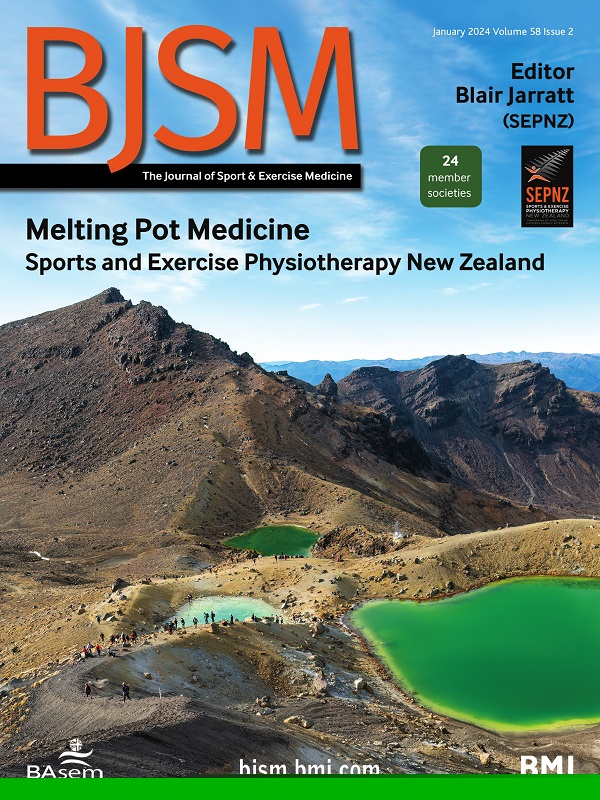Neurophysiological characteristics accompanying runners with Achilles tendinopathy and their influence in triceps surae performance (PhD Academy Award)
IF 16.2
1区 医学
Q1 SPORT SCIENCES
引用次数: 0
Abstract
My PhD aimed to explore the influence of cortical and corticospinal mechanisms of motor control and their influence in plantarflexor performance in runners with Achilles tendinopathy and whether it affected each muscle of the triceps surae differently (figure 1). Alongside neurophysiological measures, I also measured plantarflexor peak isometric torque, using isokinetic dynamometry, and endurance, as the maximal number of single-leg heel raises (SLHR). The first study focused on the brain’s role in motor control, where I investigated short-interval intracortical inhibition (SICI) to the triceps surae. In the second study, I shifted attention to α-motoneurons, specifically motor units, which consist of a group of muscle fibres innervated by the same α-motoneuron. This study explored the central nervous system’s independent control of each triceps surae muscle during isometric contractions and examined whether these control strategies differ between individuals with and without Achilles tendinopathy. Finally, I investigated a potential strategy to selectively increase lateral gastrocnemius activation of the by positioning the foot inwards during isometric plantarflexion. Figure 1 Changes in cortical and corticospinal circuits in runners with Achilles tendinopathy and their influence on plantarflexor performance. Achilles tendinopathy is a highly prevalent injury among runners and often becomes chronic, with many patients failing to respond to conservative treatment. …跑步者跟腱病的神经生理特征及其对肱三头肌表现的影响(博士学院奖)
我的博士研究目的是探讨运动控制的皮质和皮质脊髓机制的影响,以及它们对跟腱病跑步者跖屈肌表现的影响,以及它对三头肌表面每一块肌肉的影响是否不同(图1)。除了神经生理测量,我还测量了跖屈肌峰值等距扭矩,使用等速动力学测量,以及耐力,作为单腿抬高脚跟的最大次数(SLHR)。第一项研究的重点是大脑在运动控制中的作用,我研究了三头肌表面的短间隔皮质内抑制(SICI)。在第二项研究中,我将注意力转向了α-运动神经元,特别是运动单元,它由一组由同一α-运动神经元支配的肌纤维组成。本研究探讨了中枢神经系统在等长收缩过程中对每个三头肌表面肌的独立控制,并检查了这些控制策略在患有和未患有跟腱病的个体之间是否存在差异。最后,我研究了一种潜在的策略,通过在等距跖屈时将足向内定位,选择性地增加腓肠肌外侧的激活。图1跟腱病跑步者皮质和皮质脊髓回路的变化及其对跖屈肌表现的影响。跟腱病是跑步者中非常普遍的一种损伤,通常会变成慢性损伤,许多患者对保守治疗无效。…
本文章由计算机程序翻译,如有差异,请以英文原文为准。
求助全文
约1分钟内获得全文
求助全文
来源期刊
CiteScore
27.10
自引率
4.90%
发文量
217
审稿时长
3-8 weeks
期刊介绍:
The British Journal of Sports Medicine (BJSM) is a dynamic platform that presents groundbreaking research, thought-provoking reviews, and meaningful discussions on sport and exercise medicine. Our focus encompasses various clinically-relevant aspects such as physiotherapy, physical therapy, and rehabilitation. With an aim to foster innovation, education, and knowledge translation, we strive to bridge the gap between research and practical implementation in the field. Our multi-media approach, including web, print, video, and audio resources, along with our active presence on social media, connects a global community of healthcare professionals dedicated to treating active individuals.

 求助内容:
求助内容: 应助结果提醒方式:
应助结果提醒方式:


